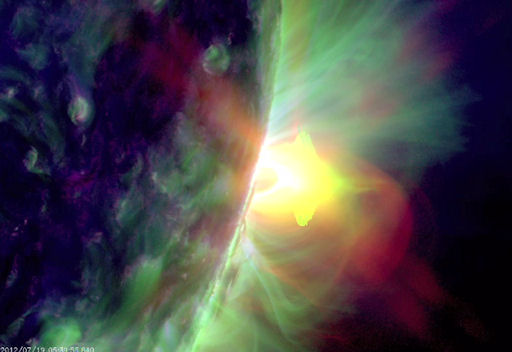MARTIAN MARATHON: More than 8 years after landing on the Red Planet, Mars rover Opportunity is still running. Indeed, mission planners say the tireless robot is poised to complete a full marathon--the first ever long-distance race on an alien planet. [full story] [video]
ALMOST X-FLARE : Sunspot complex AR1520-1521 erupted again on July 19th, this time producing an M7-class solar flare that almost crossed the threshold into X-territory. NASA's Solar Dynamics Observatory recorded the extreme ultraviolet flash:
The explosion produced a bright coronal mass ejection: movie. The cloud should miss Earth.
Although the explosion occured on the other side of the sun's western limb, our planet could feel some effects. The blast site is magnetically connected to Earth by backward-spiralling lines of magnetic force. Protons accelerated by the flare are being guided to us by those lines of magnetism, and a mild radiation storm is underway. Solar flare alerts: text, voice.

![]()
Solar wind
speed: 401.9 km/sec
density: 0.9 protons/cm3
explanation | more data
Updated: Today at 1357 UT
![]()
X-ray Solar Flares
6-hr max: M3 0701 UT Jul19
24-hr: M7 0558 UT Jul19
explanation | more data
Updated: Today at: 1300 UT
![]()
![]()
![]()
Daily Sun: 19 Jul 12
![]()
![]()
Departing sunspot 1520 poses a threat for M-class solar flares. Credit: SDO/HMI
![]()
![]()
![]()
Sunspot number: 59
What is the sunspot number?
Updated 17 Jul 2012
Spotless Days
Current Stretch: 0 days
2012 total: 0 days (0%)
2011 total: 2 days (<1%)
2010 total: 51 days (14%)
2009 total: 260 days (71%)
Since 2004: 821 days
Typical Solar Min: 486 days
Updated 17 Jul 2012
The Radio Sun
10.7 cm flux: 138 sfu
explanation | more data
Updated 17 Jul 2012
![]()
![]()
![]()
Current Auroral Oval:
![]()
Switch to: Europe, USA, New Zealand, Antarctica
Credit: NOAA/POES
![]()
![]()
![]()
Planetary K-index
Now: Kp= 1 quiet
24-hr max: Kp= 2 quiet
explanation | more data
![]()
Interplanetary Mag. Field
Btotal: 4.9 nT
Bz: 0.2 nT south
explanation | more data
Updated: Today at 1356 UT
![]()
![]()
![]()
Coronal Holes: 18 Jul 12
![]()
![]()
A solar wind stream flowing from this coronal hole should reach Earth on or about July 21st. Credit: SDO/AIA.





